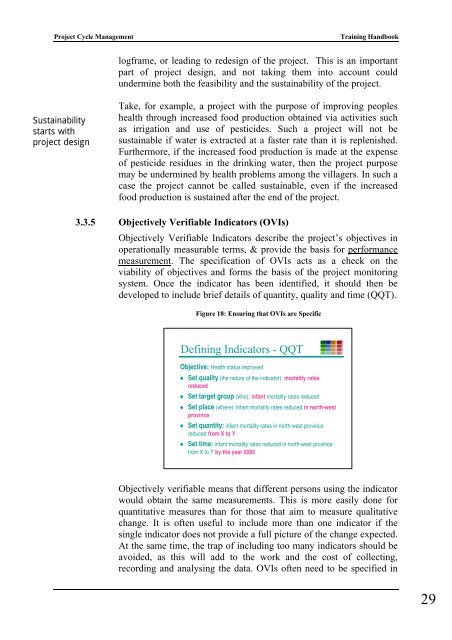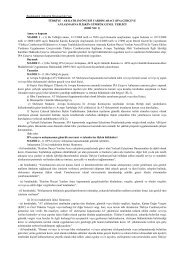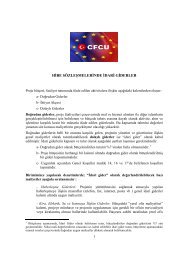Project Cycle Management Training Handbook - CFCU
Project Cycle Management Training Handbook - CFCU
Project Cycle Management Training Handbook - CFCU
You also want an ePaper? Increase the reach of your titles
YUMPU automatically turns print PDFs into web optimized ePapers that Google loves.
<strong>Project</strong> <strong>Cycle</strong> <strong>Management</strong> <strong>Training</strong> <strong>Handbook</strong><br />
Sustainability<br />
starts with<br />
project design<br />
logframe, or leading to redesign of the project. This is an important<br />
part of project design, and not taking them into account could<br />
undermine both the feasibility and the sustainability of the project.<br />
Take, for example, a project with the purpose of improving peoples<br />
health through increased food production obtained via activities such<br />
as irrigation and use of pesticides. Such a project will not be<br />
sustainable if water is extracted at a faster rate than it is replenished.<br />
Furthermore, if the increased food production is made at the expense<br />
of pesticide residues in the drinking water, then the project purpose<br />
may be undermined by health problems among the villagers. In such a<br />
case the project cannot be called sustainable, even if the increased<br />
food production is sustained after the end of the project.<br />
3.3.5 Objectively Verifiable Indicators (OVIs)<br />
Objectively Verifiable Indicators describe the project’s objectives in<br />
operationally measurable terms, & provide the basis for performance<br />
measurement. The specification of OVIs acts as a check on the<br />
viability of objectives and forms the basis of the project monitoring<br />
system. Once the indicator has been identified, it should then be<br />
developed to include brief details of quantity, quality and time (QQT).<br />
Figure 18: Ensuring that OVIs are Specific<br />
Defining Indicators - QQT<br />
Objective: Health status improved<br />
♦ Set quality (the nature of the indicator): mortality rates<br />
reduced<br />
♦ Set target group (who): infant mortality rates reduced<br />
♦ Set place (where): infant mortality rates reduced in north-west<br />
province<br />
♦ Set quantity: infant mortality rates in north-west province<br />
reduced from X to Y<br />
♦ Set time: infant mortality rates reduced in north-west province<br />
from X to Y by the year 2005<br />
Objectively verifiable means that different persons using the indicator<br />
would obtain the same measurements. This is more easily done for<br />
quantitative measures than for those that aim to measure qualitative<br />
change. It is often useful to include more than one indicator if the<br />
single indicator does not provide a full picture of the change expected.<br />
At the same time, the trap of including too many indicators should be<br />
avoided, as this will add to the work and the cost of collecting,<br />
recording and analysing the data. OVIs often need to be specified in<br />
29





